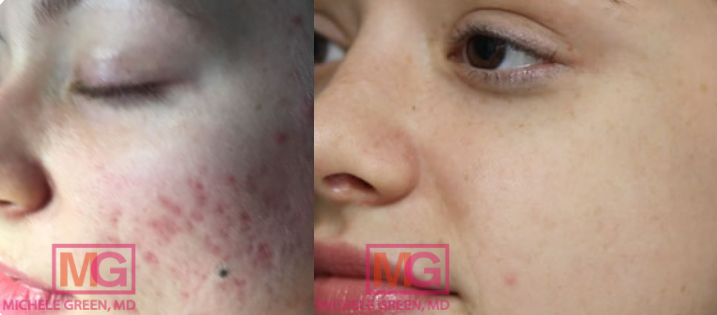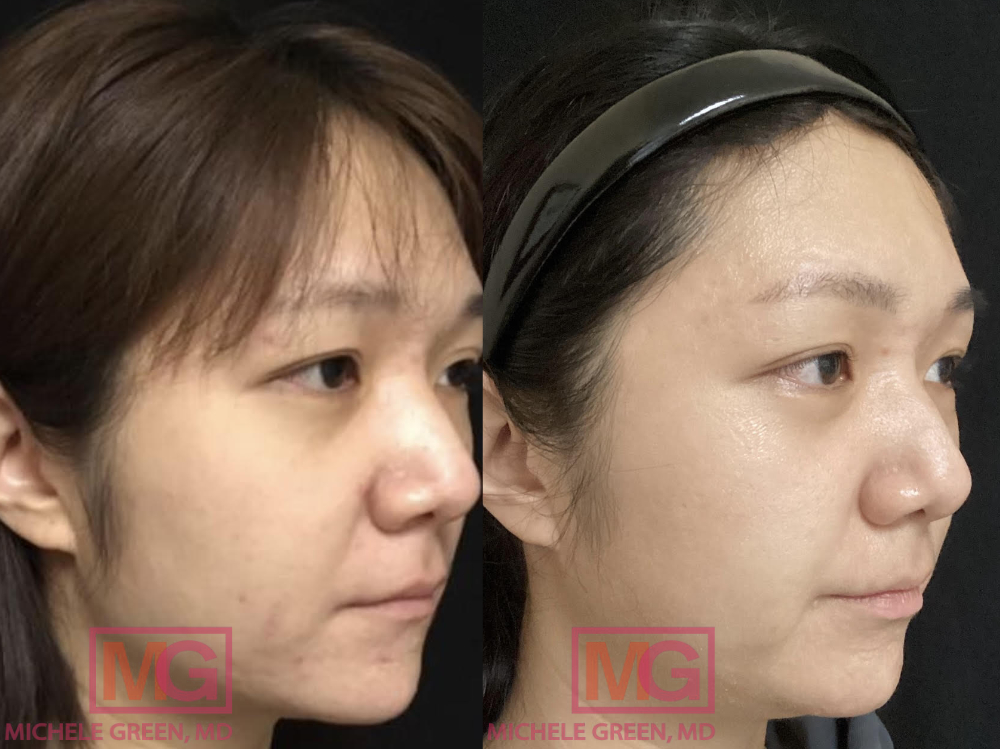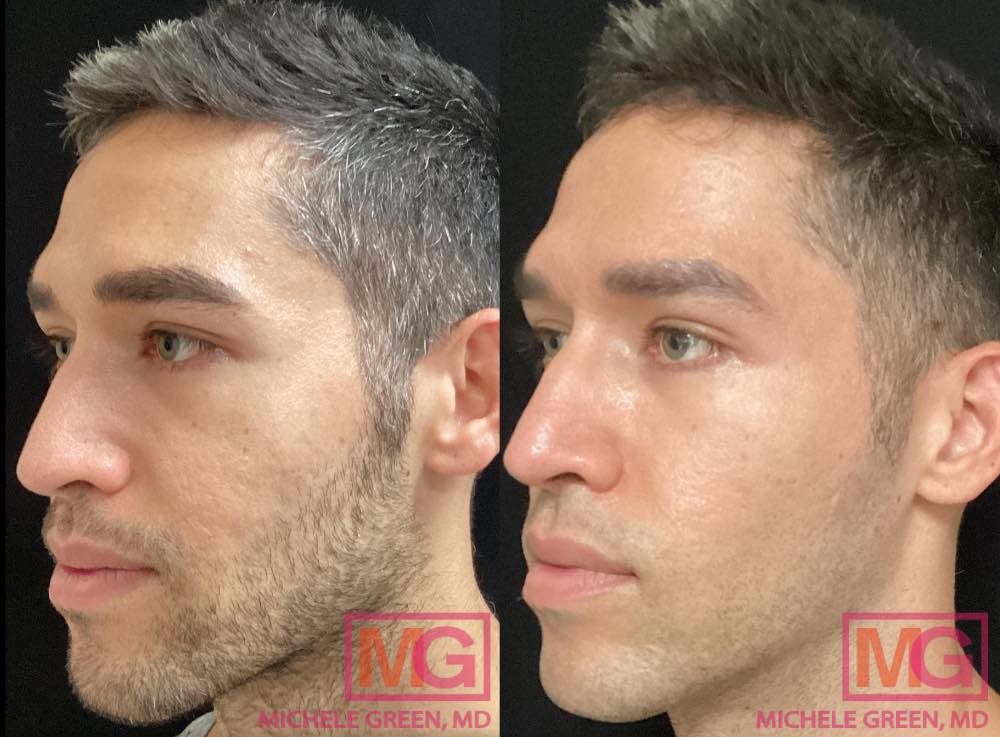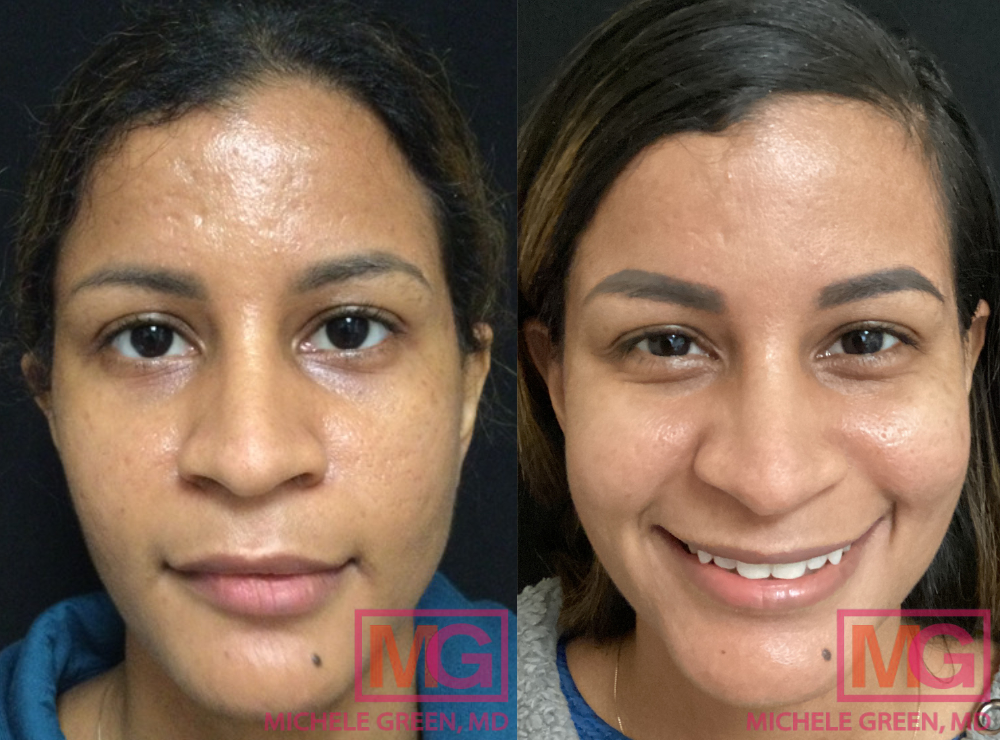Which Dermal Filler is Best for Acne Scars
Acne is one of the most common skin conditions, affecting as many as 50 million Americans, according to the American Academy of Dermatology. While acne breakouts are already frustrating, approximately 40% of individuals who experience active acne breakouts will develop acne scars. Severe acne lesions, such as nodules, cysts, and inflammatory acne, can cause damage to the soft tissue, interrupting regular collagen production and leading to different types of acne scars. When damage to soft tissue leads to an inability to produce sufficient collagen, atrophic scars, characterized by depressions on the skin’s surface, are formed, but when soft tissue damage causes an over-production of collagen, hypertrophic scars form, which are characterized by firm, raised scar tissue. Atrophic and hypertrophic acne scars will not go away on their own, leading patients to wonder about the most effective treatment available to reduce the appearance of acne scars. Luckily, expert, board-certified dermatologist Dr. Michele Green has many treatment options available at her New York City dermatology office for the treatment of acne scars.
One highly effective treatment for atrophic acne scars is dermal filler, a noninvasive injectable treatment with no downtime required. Filler injections can address a wide range of cosmetic concerns, including volume loss, fine lines, and contouring, and they can also reduce the appearance of acne scars by filling in depressions and smoothing the skin. Many different types of filler are available for cosmetic use. Still, for the treatment of acne scars, Dr. Green will typically turn to hyaluronic acid fillers, such as Juvederm or Restylane, poly-L-lactic acid fillers, such as Sculptra or polymethyl methacrylate microsphere-based filler (PMMA), such as Bellafill. These filler treatments range from temporary to semi-permanent, providing patients with long-lasting results. Typically, dermal filler treatment for acne scarring is most effective when combined with other skin treatments, such as chemical peels, fractional laser resurfacing treatment, microneedling, subcision, and V-beam laser treatment for hyperpigmentation. To find out which treatment options will best meet your needs, schedule your consultation appointment with Dr. Green.
With over 25 years of experience, Dr. Michele Green, a board-certified dermatologist, has been providing expert care to patients in her Upper East Side New York City office. Her extensive knowledge in treating various skin conditions and her ability to create personalized skin care and treatment plans have helped numerous patients maintain smooth and clear skin. Dr. Green’s expertise extends to reducing signs of aging and blemishes on the face for patients of all skin types, using a combination of dermal filler treatments, laser treatments, chemical peels, Botox, and more. Her commitment to patient satisfaction has earned her recognition as one of the top dermatologists in New York City, as voted by reputable publications such as Castle Connolly, Super Doctors, and New York Magazine.

What are acne scars?
Acne scars form when severe acne damages the soft tissue under the surface of the skin, disrupting the healing process. Depending on the type of acne breakout, the body’s ability to heal deep wounds, and the depth and severity of the infection, different types of acne scars can form on the skin’s surface. Suppose the infection is deep and the wound is large, or your skin is too delicate. In that case, the body may be unable to produce sufficient collagen to repair the damage, leading to depressions on the skin’s surface, known as atrophic scars. Three types of atrophic scars may appear on the skin: ice pick scars, boxcar scars, or rolling acne scars. Ice pick scars are characterized by deep and narrow depressions that can look like enlarged pores. They form most often due to deep, severe inflammatory acne, such as cysts or nodules. Boxcar scars appear as round, oval-shaped depressions with deep vertical sides caused by inflammatory acne that destroyed the collagen fibers at the infection site. Boxcar scars differ from icepick scars in that boxcar scars have wider depressions. Rolling scars have sloping edges, making the skin appear wavy and uneven. They appear most often on the lower cheeks and along the jawline, where the skin is thicker and may extend beyond where the acne breakout was originally.
The other overarching type of acne scar is the hypertrophic scar—or keloid scar—which means a raised scar. Hypertrophic scars form when inflammatory acne triggers an overproduction of collagen, leading to the appearance of thick and lumpy scar tissue. Typically, keloid scars grow to be bigger than the original acne lesion and can continue to expand even after the breakout has resolved. Hypertrophic scars should only be treated by an experienced board-certified dermatologist or plastic surgeon to avoid further irritation to the skin. Following a severe acne breakout, patients may also experience post-inflammatory hyperpigmentation, which is when discoloration or dark spots appear after infected acne lesions heal. When an acne breakout becomes infected, inflammation at the infection site causes melanin production to occur.
What are dermal fillers?
Dermal fillers are a type of injectable treatment that can be used for multiple cosmetic purposes, including reversing volume loss, reducing the appearance of fine lines and wrinkles, such as nasolabial folds, contouring the face, and filling in atrophic acne scars. Dermal filler treatment can be used on the hands and across many areas of the face, including under the eyes, in the cheeks, around the nose and mouth, in the lips, and along the chin and jawline. With many varieties of formulations and active ingredients, dermal fillers can be safely used to address a wide range of cosmetic concerns, providing patients with smooth, contoured, youthful-looking skin. A non-invasive treatment, dermal fillers require no downtime following the injections, meaning patients can immediately resume their regularly scheduled activities.

What are the different types of dermal fillers?
Dermal fillers come in a range of formulations with different active ingredients, meaning each type of dermal filler can be used for a slightly different purpose and range from temporary to semi-permanent to permanent fillers. The most common dermal fillers, which are available at Dr. Green’s New York City dermatology office, include hyaluronic acid-based fillers like Restylane, Juvederm, and Belotero, the poly-L-lactic acid-based filler Sculptra, the calcium hydroxyapatite-based filler Radiesse, and PMMA/bovine collagen-based filler Bellafill. When treating acne scars, Dr. Green will typically turn to Juvederm, Restylane, Sculptra, or Bellafill.
Hyaluronic Acid Dermal Fillers
Hyaluronic acid (HA) dermal fillers contain the naturally occurring ingredient of hyaluronic acid, which helps to boost collagen production at the injection site, fill in lost volume, and hydrate the skin. The most commonly used types of HA fillers are the Juvederm and Restylane families of dermal fillers, which differ in the proprietary cross-linking technology used to provide structural support within the injection. The results of hyaluronic acid filler treatment can be seen right away. They will continue to improve slightly over time as collagen production is triggered at and around the injection site. The effects of the treatment are temporary and typically last for six months to a year. Patients can schedule a touch-up appointment once or twice annually to maintain the results of the treatment.
Poly-L-Lactic Acid Dermal Fillers
Sculptra is a dermal filler containing the active ingredient poly-L-lactic acid, which triggers significant collagen production at the injection site to fill in lost volume. FDA-approved specifically to address volume loss in the midface, Sculptra can also be used to fill in depressed acne scars, such as icepick scars and boxcar scars. Unlike hyaluronic acid fillers, which provide immediate results, the effects of Sculptra injections improve over time as collagen production increases. The effects of Sculptra injections can last for up to two years before requiring another round of treatment.
Bellafill
Bellafill is the only dermal filler specifically FDA-approved to treat atrophic acne scars on the cheeks. A semi-permanent dermal filler, Bellafill is composed of polymethyl methacrylate microspheres (tiny beads), which provide structural support to the skin, and bovine collagen, which immediately adds volume to the treatment area. Over time, the bovine collagen is absorbed and broken down by the body, leaving the PMMA to provide structural support, meaning that the treatment is very long-lasting.
Can dermal fillers help acne scars?
Dermal fillers are an excellent treatment option for addressing atrophic acne scars, such as icepick scars and boxcar scars. Typically, Dr. Green will turn to Juvederm, Restylane, Sculptra, or Bellafill to address acne scars, filling in depressions on the skin for a smooth, clear look to the skin’s surface. Dermal fillers are an excellent alternative to a more invasive fat grafting treatment, which involves liposuction to remove fat from another area of the body with the goal of filling in depressions on the skin. Dermal fillers provide a non-invasive option for filling in atrophic scars with results that last for one to two years. Clinical studies have demonstrated that patients are satisfied with dermal filler treatment used to help acne scars.
How do dermal fillers work for acne scar treatment?
Dermal fillers work to treat atrophic acne scars, which are characterized by depressions on the skin’s surface. Filler treatment fills in lost volume, provides structural support, and boosts collagen production to reduce the appearance of depressions. Depending on the type of dermal filler used, the active ingredient and mechanism of action for filling in the depressions will differ. Hyaluronic acid fillers, such as Juvederm and Restylane, provide patients with immediate results, as the hyaluronic acid fills in lost volume, plumps and hydrates the skin, and triggers collagen production. The results of Sculptra treatment appear more gradually as collagen production at the injection site increases, which helps to repair the damaged skin and restore lost volume. Bellafill also provides lift to the skin with the bovine collagen present in the injection to make the scars less noticeable. Then, as the body absorbs the bovine collagen over time, the PMMA microspheres stay in place to provide continued structural support at the treatment site.
Dermal filler treatment is a quick and simple procedure that requires no recovery time and has a very low risk of any serious side effects. When patients arrive at Dr. Green’s office, she will begin by examining the treatment area and recommending the treatment—or series of treatments—that will best meet your needs and aesthetic goals. If Dr. Green believes Bellafill is the best option for you, she will perform an allergy test to ensure that you will not have an allergic reaction to the bovine collagen present in the injection. Before the treatment session, Dr. Green’s office will provide a topical numbing cream for you to apply to reduce any potential discomfort during the procedure. Most patients do not experience significant pain or discomfort during the process, and the risk of significant side effects is low. Following the procedure, patients can immediately return to their regularly scheduled activities.
What are the side effects of dermal fillers for acne scars?
Dermal fillers are a safe and effective treatment for acne scars with minimal risk of serious side effects. Some common side effects of dermal fillers, like any injectable treatment, include swelling, bruising, redness, and itching, though these effects should resolve without the need for additional intervention within 5-10 days. Before undergoing dermal filler treatment with Bellafill, Dr. Green will test for any allergies to bovine collagen, which can cause an allergic reaction following the injection. Most dermal fillers also contain the numbing agent lidocaine, which can trigger allergic reactions as well.

Are there any natural fillers for acne scars?
Acne scars form when severe acne breakouts cause damage to the soft tissue, resulting in the inability of the skin to heal fully or properly. Once acne scars have formed on the skin’s surface, they typically will not go away on their own, requiring patients to seek out a board-certified dermatologist, such as Dr. Green, for treatment. Dermal fillers are most effective on atrophic acne scars, meaning acne scars that are characterized by depressions on the skin. Each type of dermal filler has a different composition and functions slightly differently. Juvederm and Restylane are two types of dermal fillers that have the active ingredient hyaluronic acid, which is a naturally occurring substance in the body that keeps the skin hydrated. When these dermal fillers are injected into the treatment site, the hyaluronic acid helps to provide volume, structure, and hydration for smooth, clear skin.
What is the best filler for acne scars?
Dr. Green most often turns to three types of dermal fillers for acne scars: hyaluronic acid fillers, such as Juvederm and Restylane, Sculptra, or Bellafill. Each filler has a different active ingredient, composition, and method of action. Hyaluronic acid fillers will fill in acne scars immediately, smoothing out and hydrating the skin. While hyaluronic acid fillers are highly effective at reducing the appearance of acne scars, they only last 6-12 months before requiring a touch-up. Sculptra contains the active ingredient poly-L-lactic acid and works very well to boost collagen production over time, helping to improve the structure of the skin through the body’s natural processes. Bellafill contains bovine collagen to boost the volume of the skin and PMMA microspheres to maintain the structure of the skin. No option is necessarily “the best.” Rather, when you have your consultation with Dr. Green, she will help you find the treatment option that works best for you.
What is the best dermal filler for acne?
Acne is one of the most common skin conditions, affecting as much as 10% of the population worldwide. Acne lesions occur when the pores of the skin become blocked with dead skin cells, oil, and other debris from the skin, which causes the characteristic bumps to appear on the skin’s surface. Sometimes, bacteria can also become trapped in the pores, resulting in inflammation and irritation under the skin. When the bacteria multiplies, the infection can get deeper, leading to painful cysts and nodules. To avoid the formation of acne scars, patients must treat cases of severe acne. Dermal fillers, however, are not the best treatment option for an active acne breakout. Instead, the best first step is to consult with board-certified dermatologist Dr. Green, who can prescribe topical or oral medication and work with you to develop a skincare routine that will help to clear your active acne breakouts.
Do derma fillers cause acne?
Dermal fillers have not been shown to cause acne breakouts. One potential side effect of some dermal filler treatments is the formation of small lumps under the skin’s surface, which can superficially look like acne. Lumps that form as a result of dermal fillers will typically go away on their own.
Can dermal fillers get rid of acne scars?
Acne scars are nearly impossible to get rid of completely, but dermal fillers can help to reduce the appearance of atrophic scarring on the face by filling in depressions on the skin. Dermal fillers work to restore lost volume, lift the skin, and provide structural support at the injection site, which helps to eliminate the appearance of icepick scars and boxcar scars. Studies have shown that many patients remain satisfied with their filler treatment results for years after the injections, with improvements in the appearance of the scars by over 50%.

How much do dermal fillers for acne scars cost?
The total cost of dermal filler treatment depends on a number of factors, including the type of institution at which you receive treatment, the size and scope of the treatment area, and the type of dermal filler used. Some MedSpas may have deals that bring down the price of treatment. Still, the risk of serious side effects, such as allergic reaction and injection into a blood vessel, greatly increases if you seek treatment from a less experienced injector. It is safer to receive treatment from a board-certified dermatologist, such as Dr. Green. The type of dermal filler used in treatment also affects the price of the treatment. On average, Bellafill is the most expensive filler to use for acne scar treatment. The total cost of acne scar treatment also depends on whether dermal fillers are paired with other treatments, such as ablative laser treatment, chemical peels, or microneedling. Once Dr. Green has listened to your aesthetic goals and created your full treatment plan, her office will provide a closer estimate of the total cost of treatment.
Is filler for acne scars worth it?
Dermal fillers are a safe and effective treatment option for atrophic acne scars that work to fill in depressions on the skin’s surface for a smoother appearance. Clinical studies have demonstrated the effectiveness of filler treatment in reducing the appearance of acne scars by up to 50%. While the results of most dermal filler treatments are not permanent, they can easily be repeated every six months to a year to maintain the effects of the treatment. Acne scar filler treatment is most effective when paired with other treatment options, such as ablative or non-ablative laser resurfacing, which can be used to promote skin cell turnover and new collagen production, chemical peels, which work for hyperpigmentation, active acne breakouts, and improving skin texture, V-Beam laser treatment to reduce hyperpigmentation, and microneedling.
How do I get started with dermal filler acne scar treatment today?
Acne breakouts affect millions of Americans each year, and when not treated properly, severe acne can damage the soft tissue, leading to the formation of acne scars. There are two overarching types of acne scars: atrophic scars, which are depressions in the skin’s surface due to insufficient collagen production during the healing process, and hypertrophic scars, which are raised, keloid scars that form due to an over-production of collagen during the healing process. Once formed, acne scars will not go away or fade over time, meaning that a visit to a dermatologist is required to reduce the appearance of acne scars. One of the best treatment options for atrophic scars is dermal fillers, which is an injectable treatment that adds volume and structure to the skin, improving skin texture. With many dermal filler options to choose from, the best first step in seeking treatment is to schedule a consultation appointment with expert, board-certified dermatologist Dr. Michele Green.
Dr. Michele Green is an internationally renowned board-certified dermatologist with over two and a half decades of experience providing her patients with the best non-invasive treatment options. Dr. Green takes a holistic approach and embraces a less-is-more philosophy, creating customized skincare routines and treatment plans that cater to the unique concerns and aesthetic goals of her patients. She is consistently identified as one of New York’s best dermatologists by Castle Connolly, New York Magazine, and Super Doctors for her dedication to her patients and expertise. Please call us at 212-535-3088 or email our New York City-based office today to schedule a consultation with Dr. Michele Green and develop the treatment plan for acne scars that works best for you.
 212-535-3088
212-535-3088